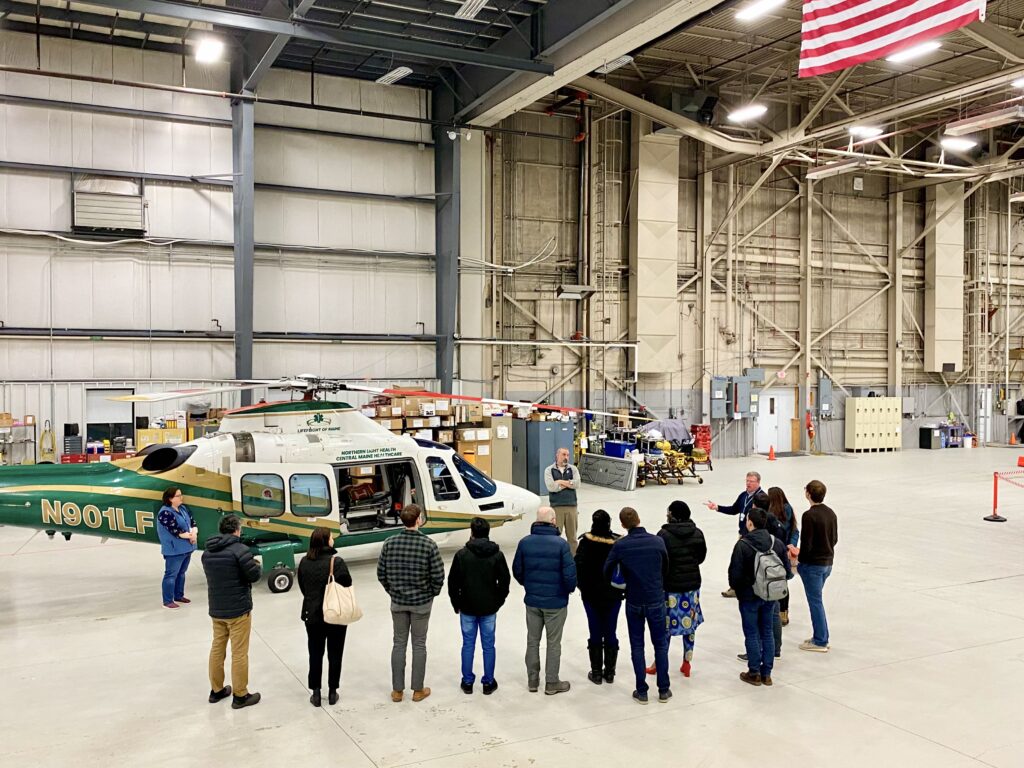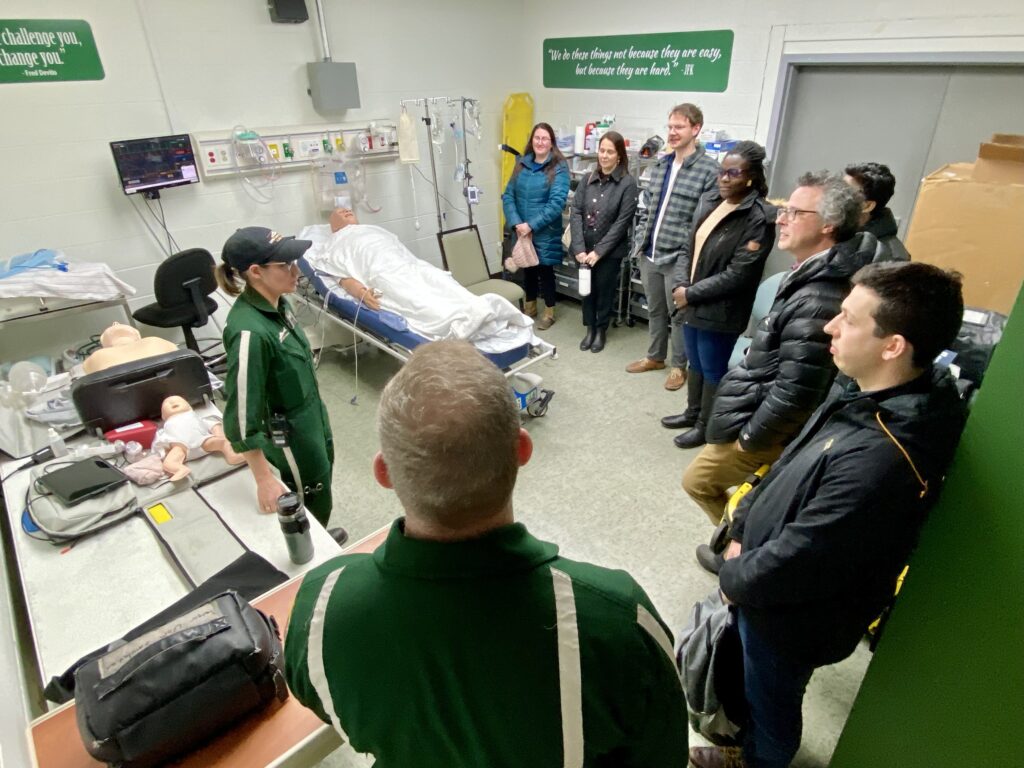Graduate students at Northeastern University’s Roux Institute analyze LifeFlight’s chute times
Operating critical care helicopters, airplanes, and ambulances is expensive, even more so in a geographically expansive and meteorologically complex place like Maine. As a nonprofit, LifeFlight of Maine benefits from the tremendous generosity of its supporters, including the state and federal governments. It has an obligation to maximize the resources it has, using them as efficiently and effectively as possible. More significantly still, LifeFlight has a duty to its mission and to the people of Maine: to provide critical care and medical transport to everyone in the State of Maine, when and where they need it.
Fulfilling this mission in the coming years and decades will require LifeFlight to continue to operate as it always has: embracing the latest advances in medicine, aviation, and other technologies to provide the best, most reliable, and safest care possible to its patients. In 2024, one of the most significant technologies on LifeFlight’s mind is artificial intelligence.
On a cold evening in January 2024, 14 graduate students stood with their professor in LifeFlight of Maine’s Bangor hangar, directing questions to LifeFlight’s Director of Aviation, Josh Dickson, and Chief Operating Officer, Bill Cyr. They were data analytics students from the Roux Institute, Northeastern University’s graduate research institute in Portland, and there were studying LifeFlight’s chute times.
A “chute time” is the time that elapses between LifeFlight’s dispatcher, MedComm, receiving a transport request and LifeFlight’s aircraft lifting off the ground. In between, there are more than 20 tasks that must be completed, some by the medical crew and some by the pilot. For example, the pilot checks weather reports to confirm it is safe to fly, and the clinical crew retrieves blood products from cold storage and places them in the aircraft. LifeFlight aims to take off in under 20 minutes. For critically ill or injured patients, every minute matters, and so responding quickly to a call is vitally important. If LifeFlight can shave 15 or 30 seconds off a handful of those tasks, that can add up to minutes, and minutes can make all the difference.

With reems of LifeFlight data in hand — going back nearly 15 years and with all patient information redacted — the Roux students broke into small groups and began applying their learning to this real-world challenge. Their objective was to identify patterns in the data and make recommendations to LifeFlight leadership on ways it might shorten chute times. Over the course of the spring semester, the students parsed the data and met with LifeFlight team members on several occasions to ask clarifying questions and gain context. The students traveled to Bangor to tour the hangar, and several of LifeFlight’s clinical and aviation leaders spent a couple evenings in a Roux Institute classroom overlooking Portland harbor.
“The impressive thing about the Roux students’ work is that the deliverables from each student team were different,” said Kate O’Halloran, Executive Director of The LifeFlight Foundation. “They were all given the same data but came up with different ideas. They were all insightful and are proving useful.”
Some data points jumped right out to the students. For example, is the aircraft inside the hangar when a call is received, or is it already outside on the tarmac? Checking weather reports was another point of inquiry. The pilot is typically allotted eight minutes to review weather reports along the projected flightpath. The students inquired about ways to shorten that review, suggesting that the analysis of real-time weather data could be performed by AI-powered softward, spitting out an answer in seconds rather than minutes. This is the kind of cutting-edge technology, which LifeFlight is eager to explore.
Other data points proved more complex. For example, how much fuel should be loaded into the aircraft before the transport request is received? On a full tank of fuel, the helicopter can fly for over an hour, which is roughly how long it takes to fly from Bangor to Fort Kent. However, fuel adds weight, and if the request comes from nearby, a fully fueled helicopter may be too heavy to transport three crew members plus a patient (weight and balance is critical in the operation of any aircraft, and especially important to helicopters like LifeFlight’s Agusta 109s). The pilot would have to drop of the clinical crew with the patient, then fly in circles to burn off fuel before loading the patient into the aircraft. On the contrary, having to add several hundred pounds of fuel to the aircraft extends the chute time. The correct answer is specific to each transport based on numerous factors. The Roux students suggested LifeFlight consider developing an AI-based program to assist with these multi-variable calculations in real time.

AI is a new and rapidly growing field, and LifeFlight of Maine has always been an early adopter. “We are lucky to have the Roux Institute here in Maine. They have a wealth of expertise right in our community,” said Bill Cyr. “AI is everywhere. Looking to the future, we want to be able to continue to provide the best service possible to the people of Maine, and we believe that embracing this technology will save lives.”
Advances in AI will create efficiencies for LifeFlight, which the data analyzed by these Roux students helped identify. But the crew will always be the heart and soul of LifeFlight. It is the crew members — pilots, paramedics, nurses, aviation maintenance technicians, and communications specialists — who save lives, not a computer or a helicopter. Much of the work done by these students is helping LifeFlight identify efficiencies and best practices among LifeFlight’s teams. Which teams seem to get off the ground most quickly, and what can their colleagues learn from them? Can we identify sticking points that slow down the process, and develop new, swifter processes to compensate? Like any graduate-level research project, it raised as many questions as it provided answers.
This semester-long project with the Roux Institute is merely the beginning. LifeFlight of Maine and Roux Institute continue to explore ways to collaborate. As AI technology develops and data science advances, new solutions with appear. “As one of the foremost air medical providers in the nation, LifeFlight is always looking toward the future,” Cyr said. “We’re looking to the latest technology, and we’re preparing for technologies that haven’t even been developed yet. We want to ensure that we can give critically ill and injured people in Maine their best chance on their worst day, and we keep getting better at that.”

